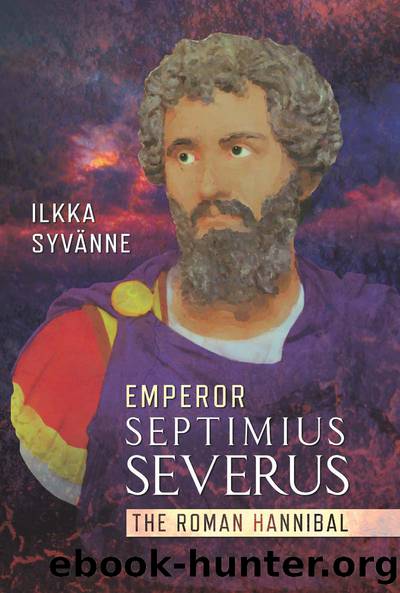Emperor Septimius Severus by Ilkka Syvnne;

Author:Ilkka Syvnne;
Language: eng
Format: epub
Publisher: Casemate Publishers & Book Distributors, LLC
Published: 2023-08-04T00:00:00+00:00
The arrival of Septimius Severus and his forces was not a surprise for Albinus, which enabled him to choose and prepare the battlefield well in advance. His plan appears to have consisted of three main elements, the first of which was to occupy the heights just north of the city of Lugdunum (Lyon). This gave him the advantage of position over his enemy and was just wide enough to accommodate his entire 150,000-strong army. The second part of his plan was to dig trenches in front of his right flank, which were then covered to hide their existence. His plan then was to lure the enemy to attack so that they would pass through a ravine, which would make their retreat difficult, into the preprepared trap. The idea was to let the enemy climb the hill and be lured to charge into the trenches and pits. It was this that made me place the site of the battle at the locale depicted in the accompanying map, it being the only one that has ravines long enough to cause the Severans trouble during their flight.19 It was a sound plan which reflected the relative strengths and weaknesses of the respective armies. Albinus was clearly aware that, despite the parity in numbers, his army was weaker than that of Severus. The only professional forces that Albinus had consisted of those he had brought from Britain. Since it is clear that he had to leave at least some troops behind to man the forts, he cannot have brought his entire force of roughly 50,000 regulars with him. He would in all probability have left at least 10,000 of these behind. However, it is probable that Albinus levied new recruits to replace those that he left behind so that the regular force he led from Britain to Gaul still consisted of about 50,000 men.
Holder has roughly calculated the number of Roman soldiers posted in Britain under Hadrian. The number of units indicated below in the first column are Holderâs, while the total numbers of soldiers are my rough estimates based on the known campaign strengths for such units and probable paper strengths:
3 legiones ca. 14,400â15,000 infantry and 1,600 cavalry
1 ala milliaria ca. 768â1,024 cavalry
10alae ca. 4,800â5,000 cavalry
6cohortes milliaria ca. 4,800â6,000 infantry
39cohortes ca. 18,780â19,500 infantry
Total: ca. 37,980â40,500 infantry and 7,168-7,624 cavalry
The general estimation for the size of the army in Britain for the period after this is over 50,000 men, and it is unlikely that it would have been any less when Albinus usurped power, hence my guess that he took with him about 50,000 regulars, the ranks of which had been filled with new recruits to replace the men left behind. The above figures give us a rough understanding of what were the relative portions of the different types of troops within Albinusâs regular forces, but it is unlikely that Albinus could significantly bolster the number of cavalry by levying new men. Therefore, my educated guess is that most of the new levies consisted of infantry.
Download
This site does not store any files on its server. We only index and link to content provided by other sites. Please contact the content providers to delete copyright contents if any and email us, we'll remove relevant links or contents immediately.
The Daily Stoic by Holiday Ryan & Hanselman Stephen(3130)
The Fate of Rome: Climate, Disease, and the End of an Empire (The Princeton History of the Ancient World) by Kyle Harper(2893)
People of the Earth: An Introduction to World Prehistory by Dr. Brian Fagan & Nadia Durrani(2632)
Ancient Worlds by Michael Scott(2515)
Babylon's Ark by Lawrence Anthony(2447)
Foreign Devils on the Silk Road: The Search for the Lost Treasures of Central Asia by Peter Hopkirk(2393)
The Daily Stoic by Ryan Holiday & Stephen Hanselman(2369)
India's Ancient Past by R.S. Sharma(2315)
MOSES THE EGYPTIAN by Jan Assmann(2290)
The Complete Dead Sea Scrolls in English (7th Edition) (Penguin Classics) by Geza Vermes(2154)
Lost Technologies of Ancient Egypt by Christopher Dunn(2133)
The Earth Chronicles Handbook by Zecharia Sitchin(2113)
24 Hours in Ancient Rome by Philip Matyszak(1985)
Alexander the Great by Philip Freeman(1974)
Aztec by Gary Jennings(1890)
The Nine Waves of Creation by Carl Johan Calleman(1799)
Curse Tablets and Binding Spells from the Ancient World by Gager John G.;(1780)
Before Atlantis by Frank Joseph(1750)
Earthmare: The Lost Book of Wars by Cergat(1726)
